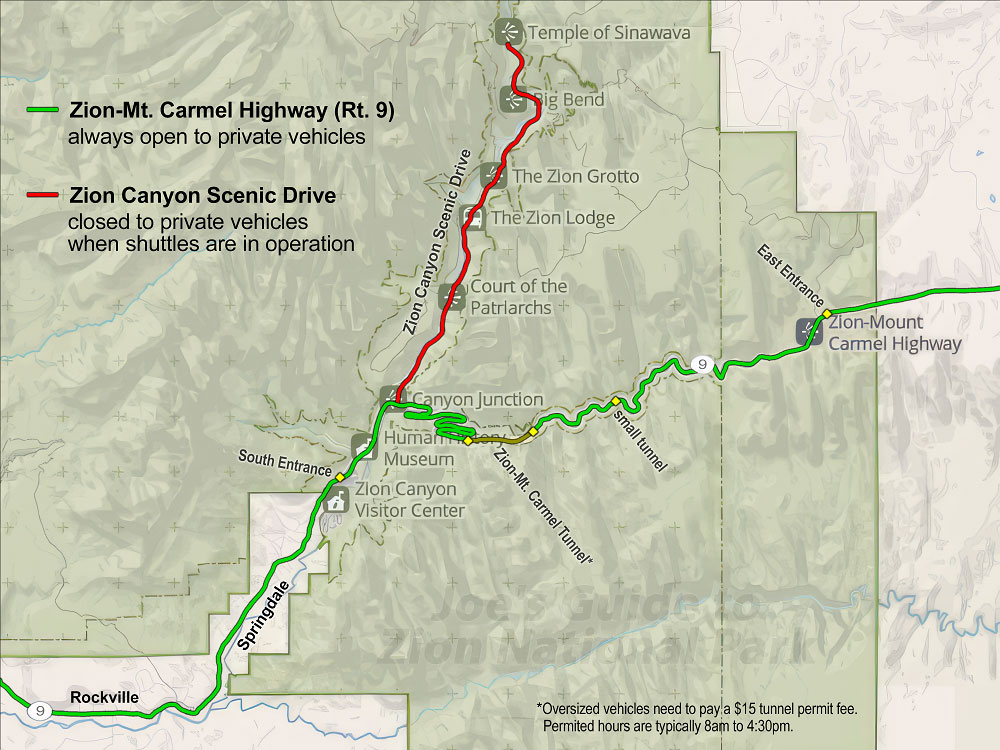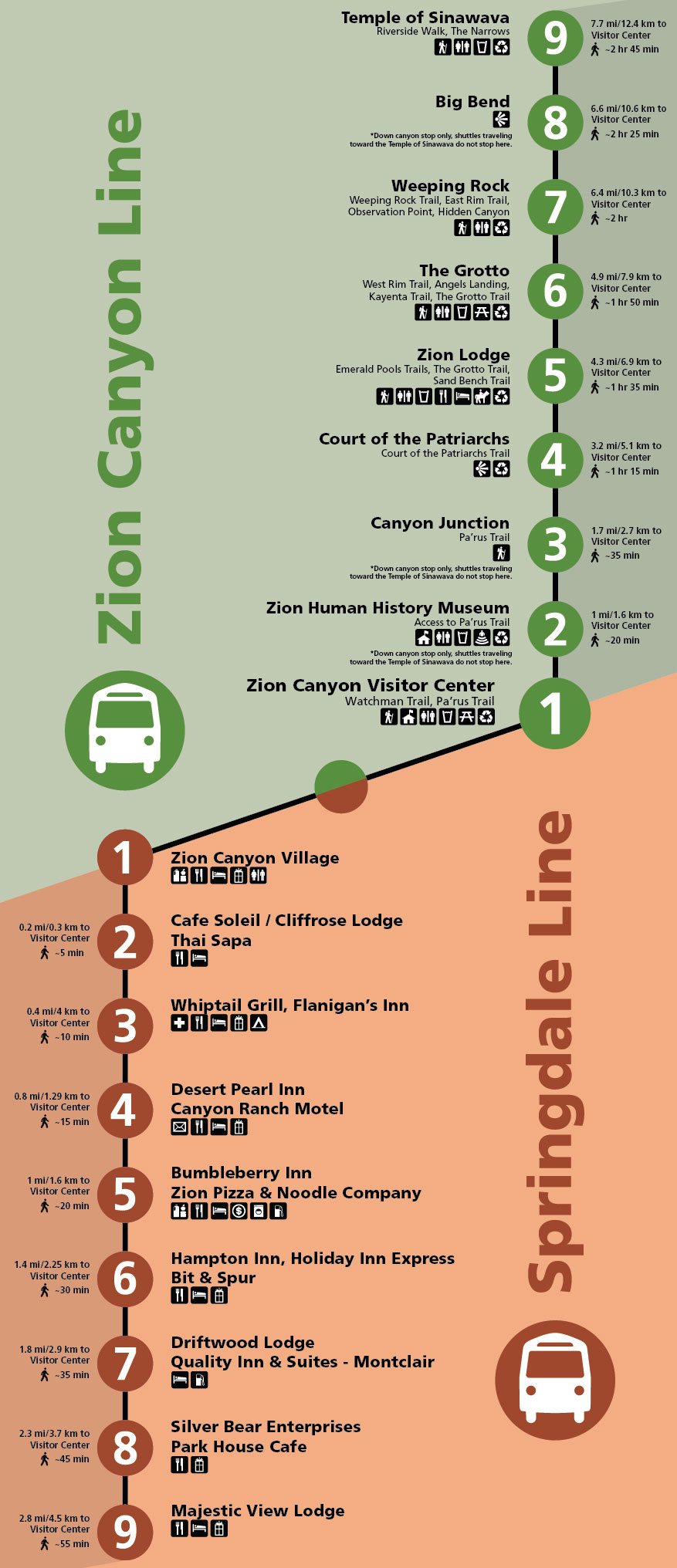DRIVING, PARKING, and the SHUTTLE SYSTEM
A Practical Guide to Zion: Page 1 2 3 4 5 6
The Zion Shuttle System:
Due to the large number of tourists visiting Zion National Park, a free shuttle bus system has been put in place to deal with traffic and parking problems in Zion Canyon and in the neighboring tourist town of Springdale. The shuttle buses operate almost year round at this point (March to November as well as popular holidays and weekends), taking a break only during the dead of winter. The Zion Canyon Line helps keep the Zion Canyon Scenic Drive serene and free from traffic jams while the Springdale Line allows people to park in numerous designated spaces and lots in the town of Springdale when the limited parking at the Zion Canyon Visitor Center has reached capacity.
Driving Private Vehicles through the Park:
Private vehicles are allowed to drive through Zion National Park along Route 9 (the Zion-Mt. Carmel Highway that connects Springdale with Mt. Carmel Junction, Bryce Canyon and the North Rim of the Grand Canyon). The closure to private vehicles during tourist season is only for the Zion Canyon Scenic Drive--the road that breaks off from Route 9 at Canyon Junction and heads up Zion Canyon towards the most popular trailheads as well as the Zion Lodge. (If you have a reservation to stay at the Zion Lodge, you are permitted to drive up the Zion Canyon Scenic Drive to get to the lodge.)
Finding Parking at the Visitor Center or in Springdale:
If you are planning on driving into Zion National Park for the day, the primary parking lot for Zion Canyon is located at the Zion Canyon Visitor Center just inside the south entrance to the park. On high visitation days, this lot typically fills up by mid-morning, so if you arrive later, you will have to find parking in one of Springdale's various parking lots or roadside parking spots and then catch a free ride on the Springdale Line to the pedestrian entrance of the park. Note that you must now pay for parking in Springdale and you will get ticketed if you park in prohibited areas like side streets that have "no public parking" signs. On high visitation days (summer tourist season, holidays, etc.), searching for parking and entering the park can be an absolute nightmare if you arrive late morning or early afternoon.
The Two Bus Lines of the Free Shuttle System:
- The Springdale Line
If you are staying in Springdale or have parked in Springdale for the day, walk to the nearest town shuttle-bus stop and a bus will take you up to the Zion Canyon Village stop near the main south entrance to Zion National Park. Cross over the pedestrian entrance bridge to pay the NPS entrance fee. The Zion Canyon Visitor Center is only a stone's throw away as is the line to ride the Zion Canyon Shuttle.
- Zion Canyon Line
Think of this as a guided tour bus within the park. Starting at the Zion Canyon Visitor Center, this free shuttle takes visitors on a scenic ride up Zion's main canyon, making several stops at interesting locations and trailheads, including the Zion Lodge, the Grotto (start of the Angels Landing hike), Weeping Rock, and the Temple of Sinawava (close to the Zion Narrows where the steep canyon walls converge). Since shuttles come regularly, feel free to get off at any spot, explore, and then get on the next shuttle. Below is a complete list of stops and what is interesting about each.
The Zion Canyon Line Stops:
- Zion Canyon Visitor Center
The Zion Canyon Shuttle starts at the Visitor Center, located just inside the main south entrance to Zion National Park near Springdale. A queue has been put in place at the stop to help round up the crowds. Also in the vicinity of the Visitor Center are the Watchman Campground, the South Campground, the
Pa'rus Trail, and the
Watchman Trail.
- Zion Human History Museum
This stop is less than a mile up the road at the Zion Human History Museum along Route 9. The museum (which was the previous Visitor Center through the 1980s) is open March through November, 10am to 5pm (or 6pm in summer). Behind the museum is a great view of the famous "Towers of the Virgin" and to the east you can catch a glimpse of the Bridge Mountain Arch. A path from the parking lot also connects with the
Pa'rus Trail.
- Canyon Junction
This stop is at the junction of Route 9 and the Zion Canyon Scenic Drive. No private vehicles are allowed to drive up the Zion Canyon Scenic Drive while the shuttle busses are in use (except for visitors staying at the Zion Lodge). This stop also provides easy access to the river and is the end of the
Pa'rus Trail.
- Court of the Patriarchs
- Zion Lodge
This is a big stop for the Zion shuttle line where many people will be getting on and off. The Zion Lodge has several restaurants, a gift shop, indoor restrooms, and a grand lawn with a majestic cottonwood tree that invites visitors to stay and relax. Across the road is the start of the
Emerald Pools Trail and the horse stables for those looking to ride along the
Sandbench Loop. The
Grotto Trail also starts here and follows the road to the next stop.
- The Grotto
The Grotto used to be a campground and the site of the original Visitor Center, but now it is an isolated picnic area with a water fountain and primitive bathrooms. It is the starting point for the legendary
Angels Landing hike,
West Rim Trail, the Kayenta Trail (an alternate approach to the
Emerald Pools Trail), and the
Grotto Trail that connects back to the Zion Lodge.
- Weeping Rock CLOSED DUE TO ROCKFALL
- Big Bend
This stop isn't the starting point for any featured trails, but you may want to get out to see a good view of the Great White Throne with Angels Landing in the foreground. Climbers can often be spotted making their way up Angels Landing. There is access to the river and trails of use if you want to hike to the previous or next stops.
- Temple of Sinawava
This is the end of the line for the shuttle, a beautifully quiet spot where everybody will want to get out and take a stroll to the river. (Bathrooms and water fountains are available.) This is the starting point for the
Riverside Walk and the classic
Zion Narrows Day Hike.
Notes on Vehicles and Shuttles:
- The National Park Service does not offer free shuttle service to any other parts of the park, but several outfitters in Springdale and the greater Zion area offer shuttle services for a fee, taking hikers to various remote trailheads such as Chamberlain's Ranch (for the Zion Narrows hike), the Subway, Lava Point, Lee Pass (in the Kolob Canyons section), and the East Entrance Trailhead.
- To see the official Zion shuttle dates and times, view the NPS Shuttle System page.
- Oversized vehicles (including motor homes, tour buses, and trailers) are required to purchase a $15 tunnel permit to go through the Zion-Mt. Carmel Tunnel. While standard-sized private vehicles can drive through 24 hours a day for free, oversized vehicles are only allowed through when rangers are present to manage traffic, typically 8am to 4:30pm. More details are available on the NPS Zion-Mount Carmel Tunnel page.
- While you can drive down the Zion Canyon Scenic Drive during a few months in the off-season, the park is still pretty popular in winter, so parking at the trailheads may still be a problem if you don't get an early morning start.
Page 6: Dealing with Crowds



